Solar UV Radiation in Saint-Denis, La Réunion and Cape Town, South Africa: 10 years Climatology and Human Exposure Assessment at Altitude
Abstract
1. Introduction
2. Experiments
2.1. UV Instruments
2.1.1. Ground-Based UVR Instrument at Saint-Denis
2.1.2. Ground-based UVR instrument at Cape Town
2.1.3. Field UVR Instrument
2.2. Methods and Statistical Analysis
2.2.1. Climatology Analysis
2.2.2. Trend Analysis
2.2.3. Case Study
3. Results and Discussion
3.1. Climatology
3.2. Trend Analysis
3.3. Case Study
4. Conclusions
Author Contributions
Funding
Acknowledgments
Conflicts of Interest
References
- Kerr, J.; Fioletov, V.; Fioletov, V. Surface ultraviolet radiation. Atmos. Ocean 2008, 46, 159–184. [Google Scholar] [CrossRef]
- Fitzpatrick, T.B. Skin Phototypes. In Proceedings of the 20th World Congress of Dermatology, Paris, France, 1–5 July 2002. [Google Scholar]
- Gallagher, R.P.; Lee, T.K. Adverse effects of ultraviolet radiation: A brief review. Biophys. Mol. Biol. 2016, 92, 119–131. [Google Scholar] [CrossRef]
- Tucker, M.A.; Shields, J.A.; Hartge, P.; Augsburger, J.; Hoover, R.N.; Fraumeni, J.F. Sunlight Exposure as Risk Factor for Intraocular Malignant Melanoma. N. Engl. J. Med. 1985, 313, 789–792. [Google Scholar] [CrossRef]
- Armstrong, B.K.; Kricker, A. How much melanoma is caused by sun exposure? Melanoma Res. 1993, 3, 395–402. [Google Scholar] [CrossRef] [PubMed]
- National Institute for Communicable Diseases. Available online: http://www.nicd.ac.za/centres/national-cancer-registry/ (accessed on 5 July 2019).
- Norval, M.; Kellett, P.; Wright, C.Y. The incidence and body site of skin cancers in the population groups of South Africa. Photodermatol. Photoimmunol. Photomed. 2013, 30, 262–265. [Google Scholar] [CrossRef] [PubMed]
- Warocquier, J.; Miquel, J.; Chirpaz, E.; Beylot-Barry, M.; Sultan-Bichat, N. Groupe de travail des dermatologues et anatomopathologistes de l’île de la Réunion; Données épidémiologiques des mélanomes cutanés à la Réunion en 2015. Ann. Dermatol. Vénéréologie 2016, 143, S313–S314. [Google Scholar] [CrossRef]
- Albert, M.R.; Ostheimer, K.G. The evolution of current medical and popular attitudes toward ultraviolet light exposure: Part 3. J. Am. Acad. Dermatol. 2003, 49, 1096–1106. [Google Scholar] [CrossRef]
- Brogniez, C.; Auriol, F.; DeRoo, C.; Arola, A.; Kujanpää, J.; Sauvage, B.; Kalakoski, N.; Pitkänen, M.R.A.; Catalfamo, M.; Metzger, J.-M.; et al. Validation of satellite-based noontime UVI with NDACC ground-based instruments: Influence of topography, environment and satellite overpass time. Atmos. Chem. Phys. Discuss. 2016, 16, 15049–15074. [Google Scholar] [CrossRef]
- Joint, I.S.O. CIE Standard 17166: 1999/CIE S007-1998 Erythema Reference Action Spectrum and Standard Erythema Dose; ISO: Vienna, Austria, 1999. [Google Scholar]
- Lamy, K.; Portafaix, T.; Brogniez, C.; Godin-Beekmann, S.; Bencherif, H.; Morel, B.; Pazmino, A.; Metzger, J.M.; Auriol, F.; DeRoo, C.; et al. Ultraviolet radiation modelling from ground-based and satellite measurements on Reunion Island, southern tropics. Atmos. Chem. Phys. Discuss. 2018, 18, 227–246. [Google Scholar] [CrossRef]
- Cadet, J.-M.; Bencherif, H.; Portafaix, T.; Lamy, K.; Ncongwane, K.; Coetzee, G.J.R.; Wright, C.Y. Comparison of Ground-Based and Satellite-Derived Solar UV Index Levels at Six South African Sites. Int. J. Environ. Res. Public Health 2017, 14, 1384. [Google Scholar] [CrossRef]
- Seckmeyer, G.; Bernhard, A.; Blumthaler, M.; Booth, C.; Lantz, K.; Webb, A. Instruments to Measure Solar Ultraviolet Radiation. Part 2: Broadband Instruments Measuring Erythemally Weighted Solar Irradiance; World Meteorological Organization (WMO): Geneva, Switzerland, 2005. [Google Scholar]
- Blumthaler, M. UV Monitoring for Public Health. Int. J. Environ. Res. Public Health 2018, 15, 1723. [Google Scholar] [CrossRef] [PubMed]
- de Paula Corrêa, M.; Godin-Beekmann, S.; Haeffelin, M.; Brogniez, C.; Verschaeve, F.; Saiag, P.; Pazmiño, A.; Mahé, E. Comparison between UV index measurements performed by research-grade. Photochem. Photobiol. Sci. 2010, 9, 459–463. [Google Scholar] [CrossRef]
- World Health Organization; International Commission on Non-Ionizing Radiation Protection. Global Solar UV Index: A practical Guide; World Health Organization: Geneva, Switzerland, 2002. [Google Scholar]
- Mahé, E.; de Paula Corrêa, M.; Godin-Beekmann, S.; Haeffelin, M.; Jégou, F.; Saiag, P.; Beauchet, A. Evaluation of tourists’ UV exposure in Paris. J. Eur. Acad. Dermatol. Venereol. 2013, 27, e294–e304. [Google Scholar] [CrossRef]
- Cede, A. Effects of clouds on erythemal and total irradiance as derived from data of the Argentine Network. Geophys. Res. Lett. 2002, 29. [Google Scholar] [CrossRef]
- Blumthaler, M.; Ambach, R.; Ellinger, R. Increase in solar UV radiation with altitude. Photochem. Photobiol. 1996, 39, 130–134. [Google Scholar] [CrossRef]
- Utrillas, M.P.; Marín, M.J.; Esteve, A.R.; Tena, F.; Cañada, J.; Estelles, V.; Martínez-Lozano, J.A.; Martínez-Lozano, J.A. Diffuse UV erythemal radiation experimental values. J. Geophys. Res. Space Phys. 2007, 112, 112. [Google Scholar] [CrossRef]
- Jumeaux, G.; Quetelard, H.; Roy, G. Atlas climatique de La Réunion; Météo-France Direction interrégionale de la Réunion: Sainte-Clotilde, La Réunion, 2002; ISBN 978-2-11-128623-8. [Google Scholar]
- Cadet, B.; Goldfarb, L.; Faduilhe, D.; Baldy, S.; Réchou, A.; Giraud, V.; Keckhut, P. A sub-tropical cirrus clouds climatology from Reunion Island (21° S, 55° E) lidar data set. Geophys. Res. Lett. 2003, 30, 1130. [Google Scholar] [CrossRef]
- Wright, C.Y.; Brogniez, C.; Ncongwane, K.P.; Sivakumar, V.; Coetzee, G.; Auriol, F.; DeRoo, C.; Sauvage, B.; Metzger, J.-M.; Metzger, J. Sunburn Risk Among Children and Outdoor Workers in South Africa and Reunion Island Coastal Sites. Photochem. Photobiol. 2013, 89, 1226–1233. [Google Scholar] [CrossRef]
- WMO (World Meteorological Organization) Assessment for Decision-Makers: Scientific Assessment of Ozone Depletion: 2014. In Global Ozone Research and Monitoring Project—Report No. 56; World Meteorological Organization: Geneva, Switzerland, 2014; p. 88. ISBN 978-9966-076-00-7.
- Fioletov, V.; Kerr, J.B.; Fergusson, A. The UV Index: Definition, Distribution and Factors Affecting It. Can. J. Public Health 2010, 101, I5–I9. [Google Scholar] [CrossRef]
- Zaratti, F.; Piacentini, R.D.; Guillén, H.A.; Cabrera, S.H.; Ben Liley, J.; McKenzie, R.L. Proposal for a modification of the UVI risk scale. Photochem. Photobiol. Sci. 2014, 13, 980–985. [Google Scholar] [CrossRef]
- Tarasick, D.W.; Fioletov, V.E.; Wardle, D.I.; Kerr, J.B.; McArthur, L.J.B.; McLiden, C.A. Climatology and trends of surface UV radiation: Survey article. Atmos. Ocean 2010, 42, 121–138. [Google Scholar] [CrossRef]
- Fountoulakis, I.; Zerefos, C.S.; Bais, A.F.; Kapsomenakis, J.; Koukouli, M.-E.; Ohkawara, N.; Fioletov, V.; De Backer, H.; Lakkala, K.; Karppinen, T.; et al. Twenty-five years of spectral UV-B measurements over Canada, Europe and Japan: Trends and effects from changes in ozone, aerosols, clouds, and surface reflectivity. Comptes Rendus Geosci. 2018, 350, 393–402. [Google Scholar] [CrossRef]
- Bais, A.F.; Lucas, R.M.; Bornman, J.F.; Williamson, C.E.; Sulzberger, B.; Austin, A.T.; Wilson, S.R.; Andrady, A.L.; Bernhard, G.; McKenzie, R.L.; et al. Environmental effects of ozone depletion, UV radiation and interactions with climate change: UNEP Environmental Effects Assessment Panel, update 2017. Photochem. Photobiol. Sci. 2018, 17, 127–179. [Google Scholar] [CrossRef] [PubMed]
- Ball, W.T.; Staehelin, J.; Haigh, J.D.; Peter, T.; Tummon, F.; Stübi, R.; Stenke, A.; Anderson, J.; Bourassa, A.; Davis, S.M.; et al. Evidence for a continuous decline in lower stratospheric ozone offsetting ozone layer recovery. Atmos. Chem. Phys. 2016, 18, 1379–1394. [Google Scholar] [CrossRef]
- Toihir, A.M.; Portafaix, T.; Sivakumar, V.; Bencherif, H.; Pazmino, A.; Bègue, N. Variability and trend in ozone over the southern tropics and subtropics. Ann. Geophys. 2018, 36, 381–404. [Google Scholar] [CrossRef]
- Leovy, C.; Sun, C.-R.; Hitchman, M.; Remsberg, E.; Russell, J.; Gordley, L.; Gille, J.; Lyjak, L. Transport of Ozone in the Middle Stratosphere: Evidence for Planetary Wave Breaking. J. Atmos. Sci. 1985, 42, 230–244. [Google Scholar] [CrossRef]
- Bencherif, H.; Portafaix, T.; Baray, J.-L.; Morel, B.; Baldy, S.; Leveau, J.; Hauchecorne, A.; Keckhut, P.; Moorgawa, A.; Michaelis, M.M.; et al. LIDAR observations of lower stratospheric aerosols over South Africa linked to large scale transport across the southern subtropical barrier. J. Atmos. Sol. Terr. Phys. 2001, 65, 707–715. [Google Scholar] [CrossRef]
- Bencherif, H.; Amraoui, L.E.; Kirgis, G.; Leclair de Bellevue, J.; Hauchecorne, A.; Mzé, N.; Portafaix, T.; Pazmiño, A.; Goutail, F. Analysis of a rapid increase of stratospheric ozone during late austral summer 2008 over Kerguelen (49.4° S, 70.3° E). Atmos. Chem. Phys. 2001, 11, 363–373. [Google Scholar] [CrossRef]
- Chepfer, H.; Noel, V.; Winker, D.; Chiriaco, M. Where and when will we observe cloud changes due to climate warming? Geophys. Res. Lett. 2014, 41, 8387–8395. [Google Scholar] [CrossRef]
- Fountoulakis, I.; Bais, A.F.; Fragkos, K.; Meleti, C.; Tourpali, K.; Zempila, M.M. Short and long-term variability of spectral solar UV irradiance at Thessaloniki, Greece: Effects of changes in aerosols, total ozone and clouds. Atmos. Chem. Phys. Discuss. 2016, 16, 2493–2505. [Google Scholar] [CrossRef]
- Cooper, O.R.; Parrish, D.D.; Ziemke, J.; Balashov, N.V.; Cupeiro, M.; Galbally, I.E.; Gilge, S.; Horowitz, L.; Jensen, N.R.; Lamarque, J.-F.; et al. Global distribution and trends of tropospheric ozone: An observation-based review. Elem. Sci. Anth. 2014, 2, 29. [Google Scholar] [CrossRef]
- Cesana, G.; Del Genio, A.D.; Ackerman, A.S.; Kelley, M.; Elsaesser, G.; Fridlind, A.M.; Cheng, Y.; Yao, M.-S. Evaluating models’ response of tropical low clouds to SST forcings using CALIPSO observations. Atmos. Chem. Phys. Discuss. 2019, 19, 2813–2832. [Google Scholar] [CrossRef]
- Koppmann, R.; Von Czapiewski, K.; Reid, J.S. A review of biomass burning emissions, part I: Gaseous emissions of carbon monoxide, methane, volatile organic compounds, and nitrogen containing compounds. Atmos. Chem. Phys. Discuss. 2005, 5, 10455–10516. [Google Scholar] [CrossRef]
- Forsyth, G.G.; Kruger, F.J.; Le Maitre, D.C. National Veldfire Risk Assessment: Analysis of Exposure of Social, Economic and Environmental Assets to Veldfire Hazards in South Africa; CSIR Report No: CSIR/NRE/ECO/ER/2010/0023/C; National Resources and the Environment CSIR; Fred Kruger Consulting cc: Stellenbosch, South Africa, March 2010. [Google Scholar]
- Young, A.R. Acute effects of UVR on human eyes and skin. Prog. Biophys. Mol. Boil. 2006, 92, 80–85. [Google Scholar] [CrossRef]
- Marionnet, C.; Tricaud, C.; Bernerd, F. Exposure to Non-Extreme Solar UV Daylight: Spectral Characterization, Effects on Skin and Photoprotection. Int. J. Mol. Sci. 2015, 16, 68–90. [Google Scholar] [CrossRef]
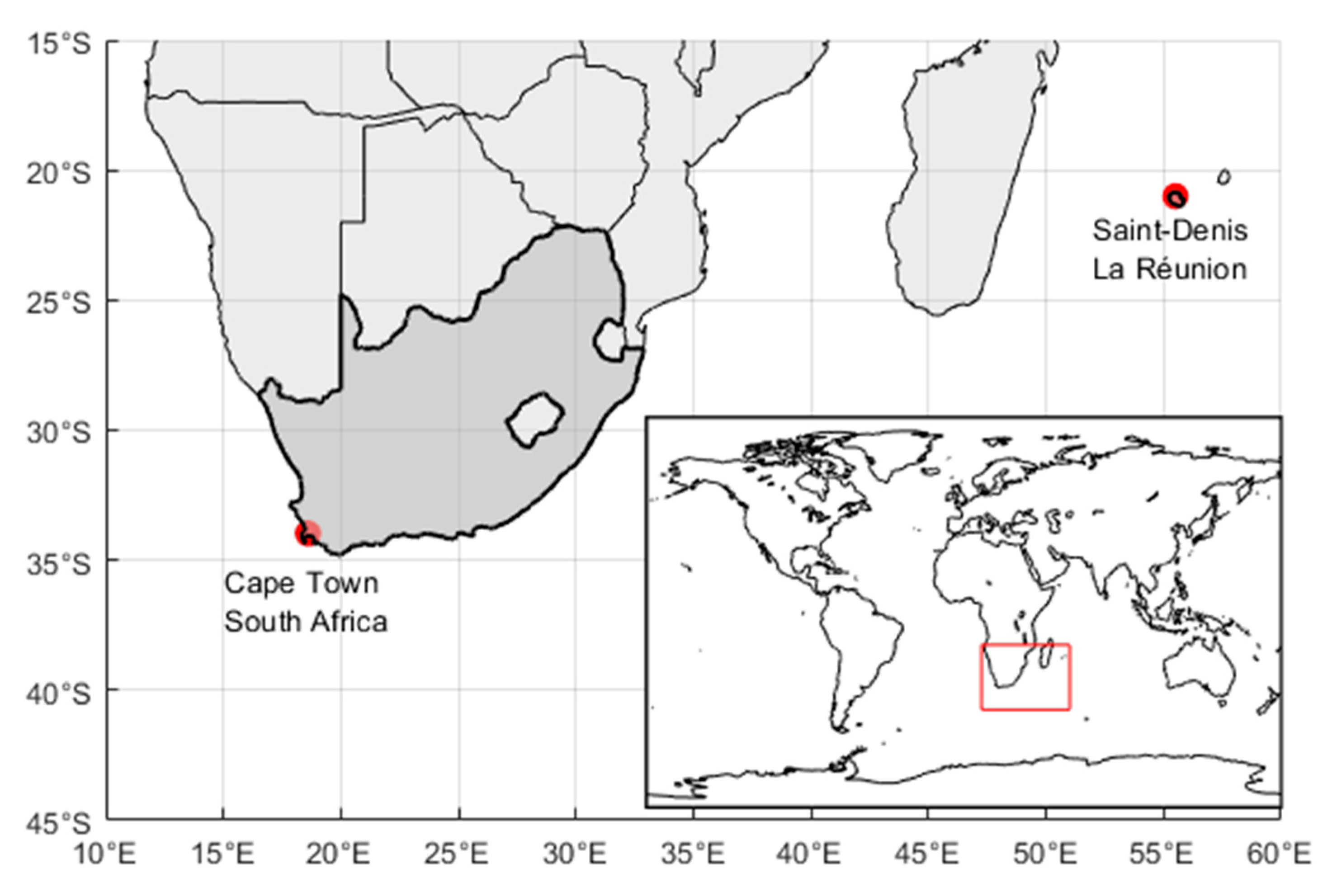
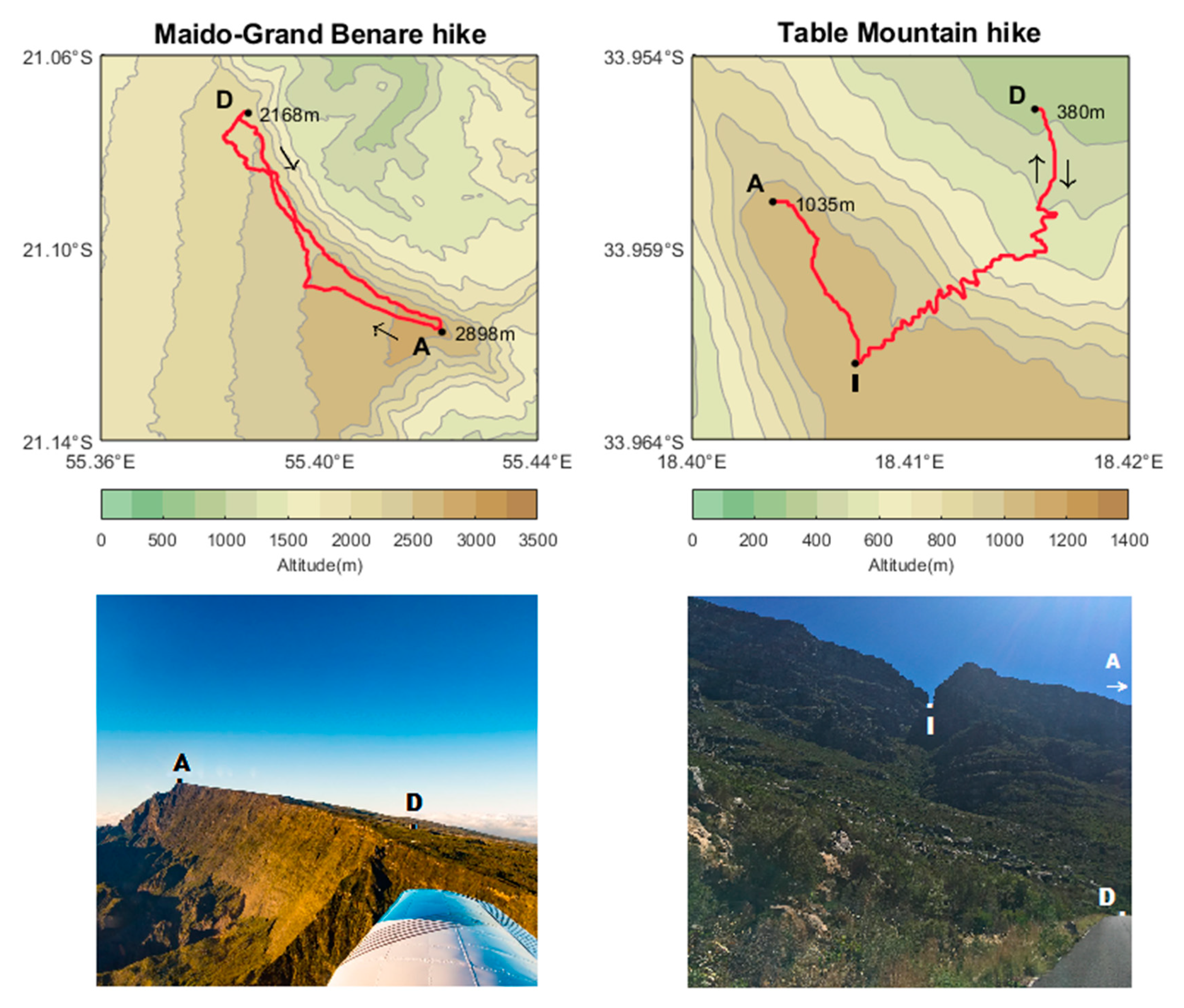
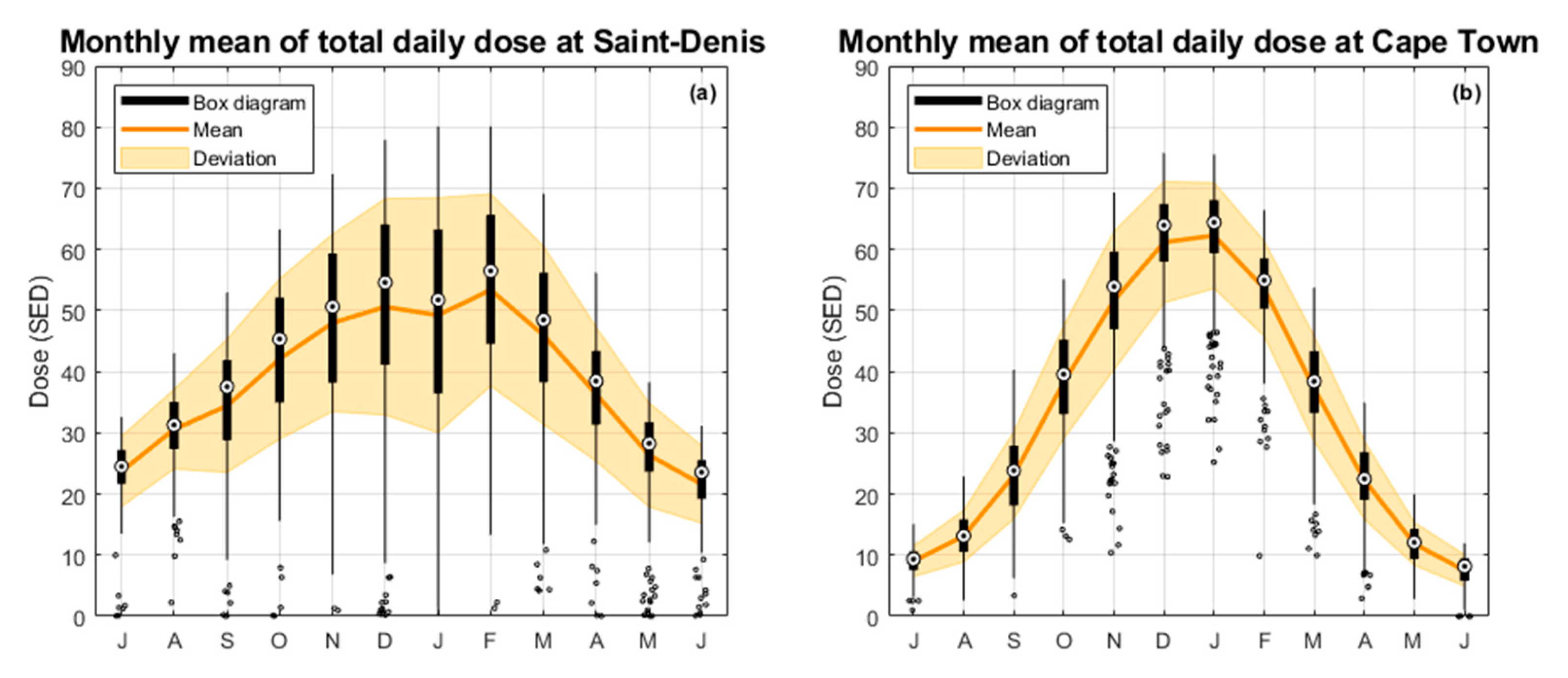
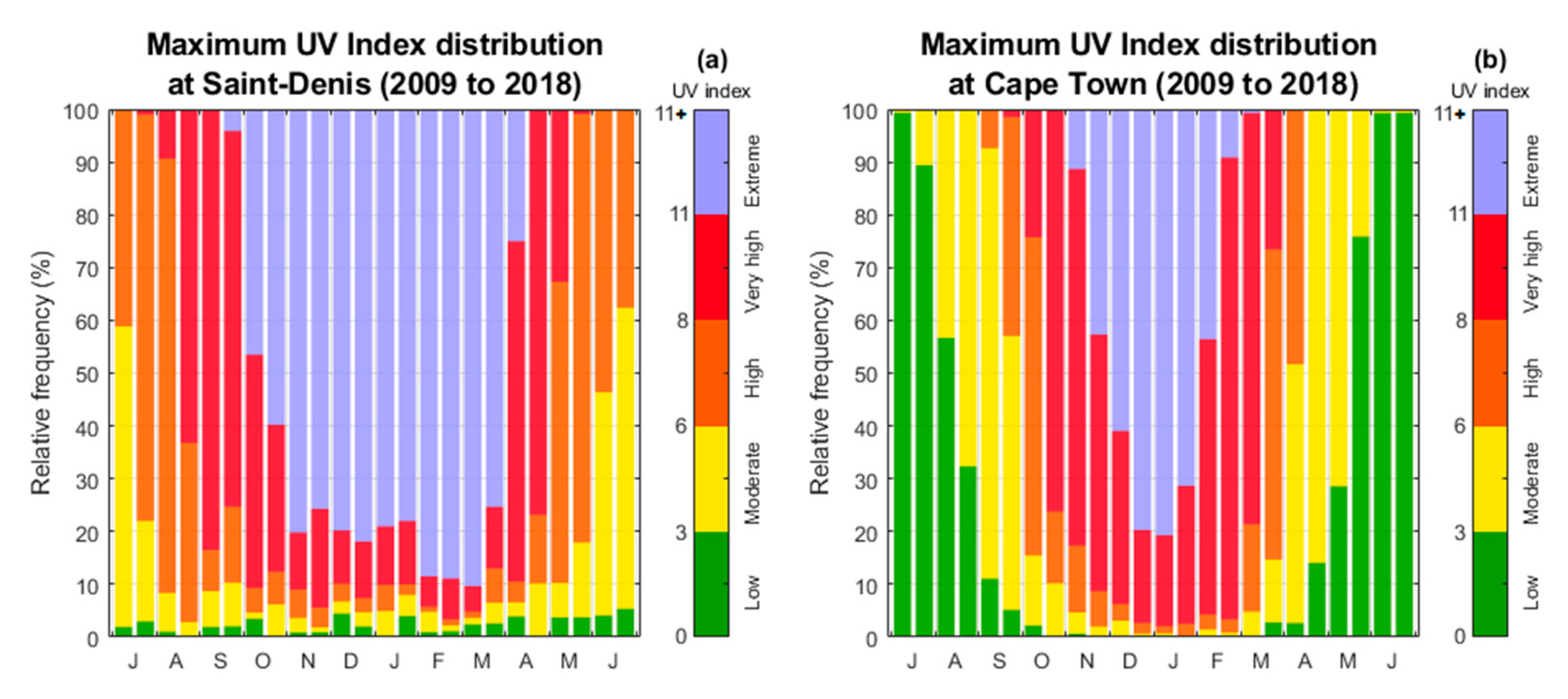
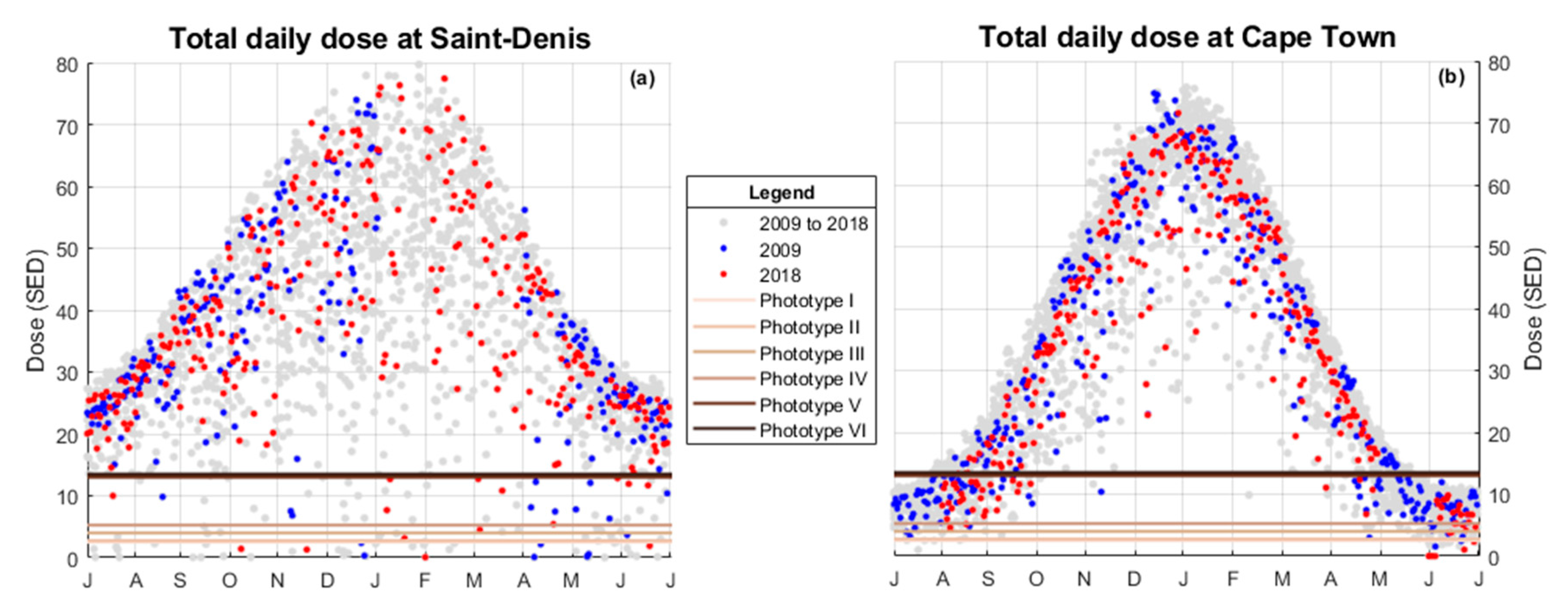
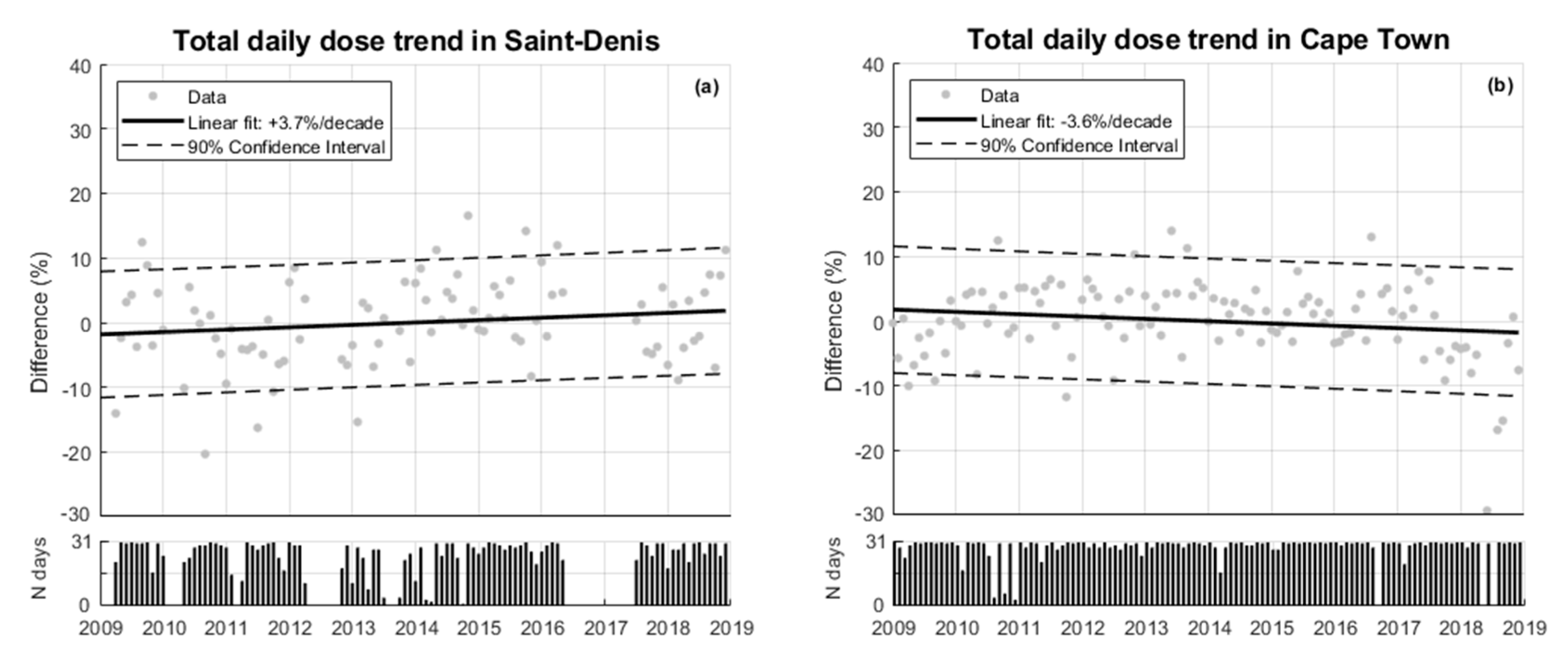
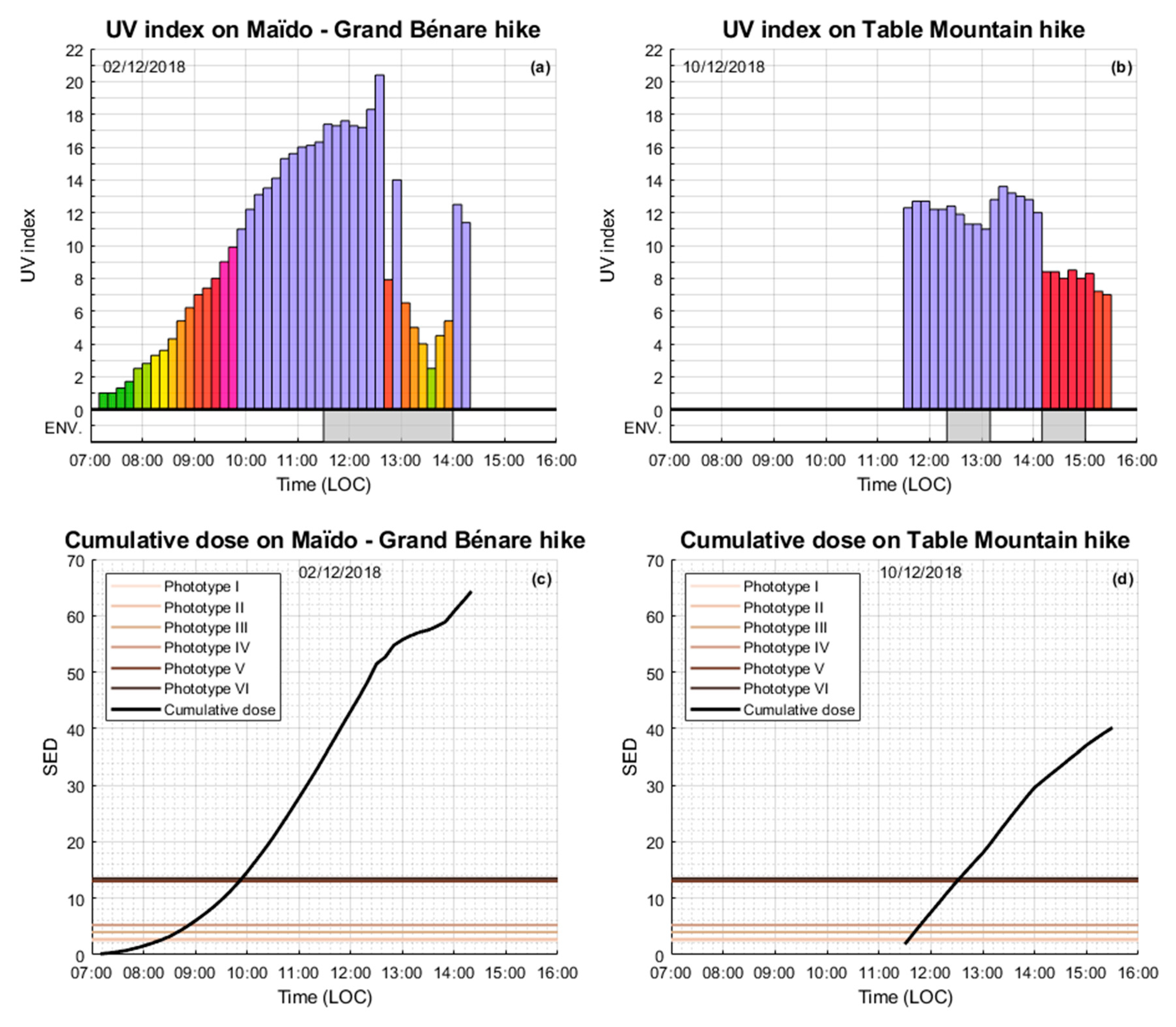
| Phototype | Characteristics | History of Sunburn | Minimal Dose to Elicit Sunburn (SED) |
|---|---|---|---|
| I | Ivory white skin, light eyes | Burns easily | 2–3 |
| II | White skin, hazel/brown eyes | Burns easily | 2.5–3 |
| III | White skin, brown eyes | Burns moderately | 3–5 |
| IV | Lightly skin, dark eyes | Burns minimally | 4.5–6 |
| V | Moderate brown skin, dark eyes | Rarely Burns | 6–20 |
| VI | Strong brown/black skin, dark eyes | Never burns | 6–20 |
| Sites | Seasonal Trends (%) | Annual Trend (%) | ||||
|---|---|---|---|---|---|---|
| DJF | MAM | JJA | SON | |||
| Saint-Denis | 20.9°S, 55.5°E, 85 m ASL | +4.5 | +6.3 | +1.7 | +1.9 | +3.7 |
| Cape Town | 33.9°S, 18.6°E, 42 m ASL | −5.0 | −5.7 | +1.0 | −4.2 | −3.6 |
© 2019 by the authors. Licensee MDPI, Basel, Switzerland. This article is an open access article distributed under the terms and conditions of the Creative Commons Attribution (CC BY) license (http://creativecommons.org/licenses/by/4.0/).
Share and Cite
Cadet, J.-M.; Bencherif, H.; du Preez, D.J.; Portafaix, T.; Sultan-Bichat, N.; Belus, M.; Brogniez, C.; Auriol, F.; Metzger, J.-M.; Ncongwane, K.; et al. Solar UV Radiation in Saint-Denis, La Réunion and Cape Town, South Africa: 10 years Climatology and Human Exposure Assessment at Altitude. Atmosphere 2019, 10, 589. https://doi.org/10.3390/atmos10100589
Cadet J-M, Bencherif H, du Preez DJ, Portafaix T, Sultan-Bichat N, Belus M, Brogniez C, Auriol F, Metzger J-M, Ncongwane K, et al. Solar UV Radiation in Saint-Denis, La Réunion and Cape Town, South Africa: 10 years Climatology and Human Exposure Assessment at Altitude. Atmosphere. 2019; 10(10):589. https://doi.org/10.3390/atmos10100589
Chicago/Turabian StyleCadet, Jean-Maurice, Hassan Bencherif, David J. du Preez, Thierry Portafaix, Nathalie Sultan-Bichat, Matthias Belus, Colette Brogniez, Frederique Auriol, Jean-Marc Metzger, Katlego Ncongwane, and et al. 2019. "Solar UV Radiation in Saint-Denis, La Réunion and Cape Town, South Africa: 10 years Climatology and Human Exposure Assessment at Altitude" Atmosphere 10, no. 10: 589. https://doi.org/10.3390/atmos10100589
APA StyleCadet, J.-M., Bencherif, H., du Preez, D. J., Portafaix, T., Sultan-Bichat, N., Belus, M., Brogniez, C., Auriol, F., Metzger, J.-M., Ncongwane, K., Coetzee, G. J. R., & Wright, C. Y. (2019). Solar UV Radiation in Saint-Denis, La Réunion and Cape Town, South Africa: 10 years Climatology and Human Exposure Assessment at Altitude. Atmosphere, 10(10), 589. https://doi.org/10.3390/atmos10100589







